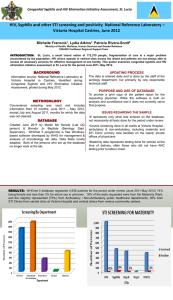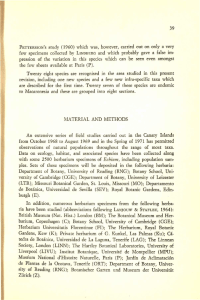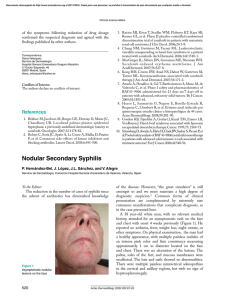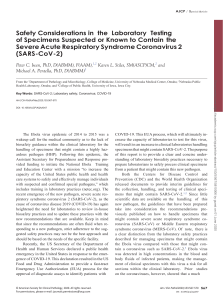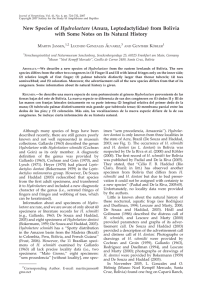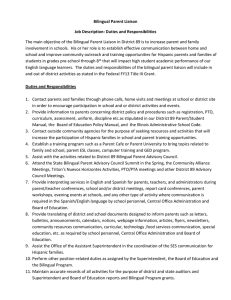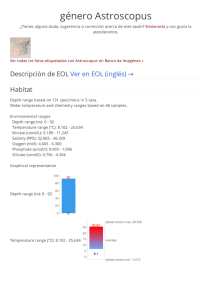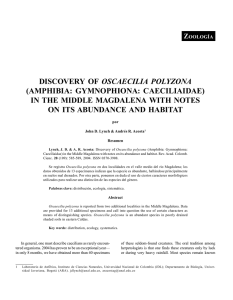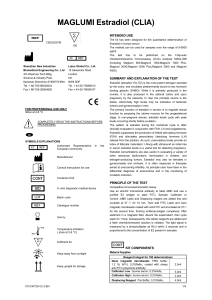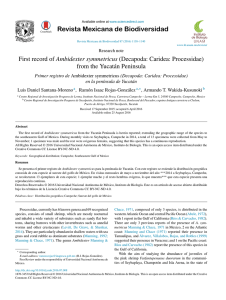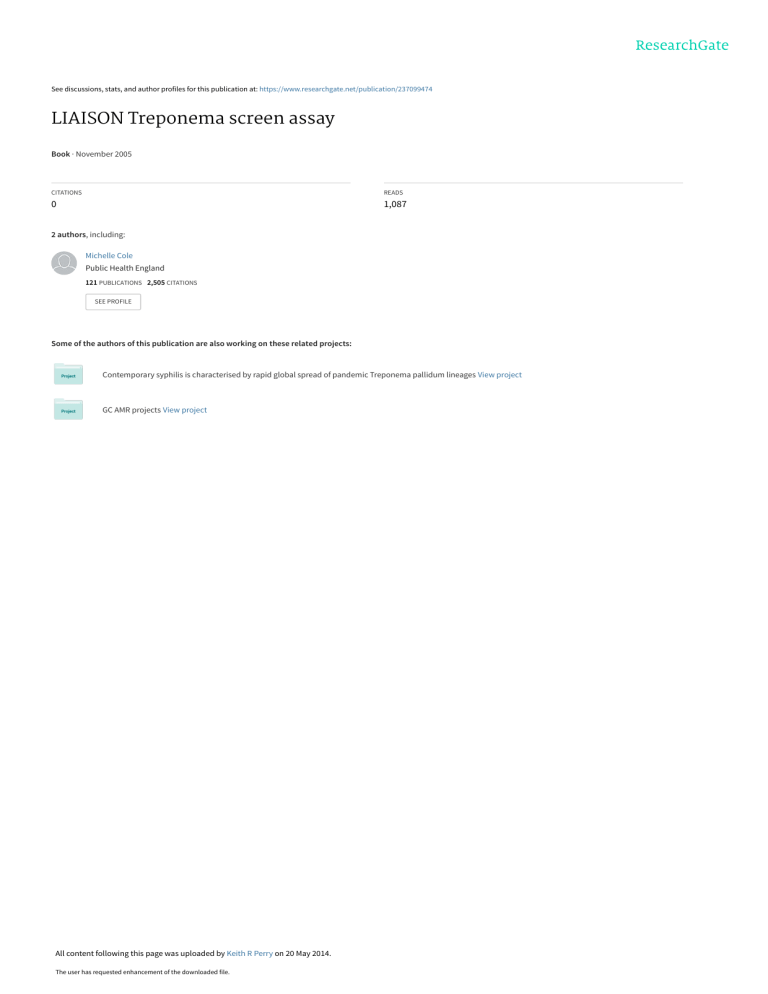
See discussions, stats, and author profiles for this publication at: https://www.researchgate.net/publication/237099474 LIAISON Treponema screen assay Book · November 2005 CITATIONS READS 0 1,087 2 authors, including: Michelle Cole Public Health England 121 PUBLICATIONS 2,505 CITATIONS SEE PROFILE Some of the authors of this publication are also working on these related projects: Contemporary syphilis is characterised by rapid global spread of pandemic Treponema pallidum lineages View project GC AMR projects View project All content following this page was uploaded by Keith R Perry on 20 May 2014. The user has requested enhancement of the downloaded file. Report 05089 LIAISON Treponema Screen assay November 2005 www.pasa.nhs.uk/cep Health and social care working together About evaluation reports The Centre for Evidence-based Purchasing provides independent and objective evaluations of medical devices available on the UK market. Specialist centres, mainly in NHS Trusts, do the evaluations under contract to the NHS Purchasing and Supply Agency (NHS PASA). Results are available on our website (www.pasa.nhs.uk/cep). Our evaluations are usually of products supplied by the manufacturer. We expect these products to be representative of those on the market but cannot guarantee this. Prospective purchasers should satisfy themselves about any modifications that might have been made after our evaluation. The Centre for Evidence-based Purchasing (formerly the Device Evaluation Service) transferred from the Medicines and Healthcare products Regulatory Agency to NHS PASA on 1 September 2005. We are currently undergoing extensive redesign to help us provide the information that purchasers want in the way they want it presented. Please visit our website to keep updated. Meanwhile, newly published evaluation reports will continue to be e-mailed to subscribers and posted on our website. How to obtain evaluation publications To order evaluation reports or to sign up for our e-mail alert service contact: Centre for Evidence-based Purchasing Room 152C, Skipton House 80 London Road London SE1 6HL Tel: 020 7972 6080 Fax: 020 7972 5795 E-mail: [email protected] All evaluation reports published since 2002 are available in full colour to download from our website: www.pasa.nhs.uk/cep Visit our website for a comprehensive list of publications, details of forthcoming evaluations, services and contacts. LIAISON Treponema Screen assay Michelle Cole, Keith Perry Microbiological Diagnostics Assessment Service (MiDAS) Evaluations and Standards Laboratory Centre for Infections Health Protection Agency 61 Colindale Avenue London NW9 5EQ Tel: 020 8327 6949 Fax: 020 8327 6009 E-mail: [email protected] For more information on MiDAS visit www.hpa-midas.org.uk © Crown Copyright 2005 Apart from any fair dealing for the purposes of research or private study, or criticism, or review, as permitted under the Copyright, Designs & Patents Act, 1998, this publication may only be reproduced, stored, or transmitted in any form or by any means with the prior permission, in writing, of the Controller of Her Majesty’s Stationery Office (HMSO). Information on reproduction outside these terms can be found on the HMSO website (www.hmso.gov.uk) or e-mail: [email protected]. Contents Summary . . . . . . . . . . . . . . . . . . . . . . . . . . . . . . . . . . . . 1 Introduction . . . . . . . . . . . . . . . . . . . . . . . . . . . . . . . . . 2 Description . . . . . . . . . . . . . . . . . . . . . . . . . . . . . . . . . . 3 Technical evalution . . . . . . . . . . . . . . . . . . . . . . . . . . . 6 Evaluation method . . . . . . . . . . . . . . . . . . . . . . . . . 6 Results . . . . . . . . . . . . . . . . . . . . . . . . . . . . . . . . . . 8 Technical appraisal . . . . . . . . . . . . . . . . . . . . . . . 15 Acknowledgements . . . . . . . . . . . . . . . . . . . . . . . . . . 16 References . . . . . . . . . . . . . . . . . . . . . . . . . . . . . . . . . 17 Report 05089: LIAISON Treponema Screen assay Appendix . . . . . . . . . . . . . . . . . . . . . . . . . . . . . . . . . . . 18 Claims for the assay and its limitations . . . . . . . . 18 Evaluation protocol . . . . . . . . . . . . . . . . . . . . . . . 19 Manufacturer’s commentsl. . . . . . . . . . . . . . . . . . 21 Summary Background In the UK, genitourinary medicine clinic attenders who are at risk of acquiring a sexually transmitted infection, blood donors at each attendance and all pregnant women, with the aim of preventing congenital syphilis, are screened for antibodies to T. pallidum. The DiaSorin LIAISON Treponema Screen assay was evaluated to determine its ability to detect anti-treponemal antibodies. Evaluation panel The evaluation panel consisted of 420 specimens. Of these, 257 were antitreponemal negative specimens from blood donors, 160 were anti-treponemal positive specimens and three were quality control samples. The positive category comprised 45 specimens from individuals whose disease stage and treatment status was known and 115 specimens from individuals whose disease stage and treatment status was unknown. Specificity findings The LIAISON Treponema Screen assay had a final specificity of 100%. Sensitivity Known disease/treatment categories - Of the 45 positive specimens with known disease/treatment categories, 44 were detected by the LIAISON Treponema Screen assay to give a sensitivity of 97.8%. Report 05089: LIAISON Treponema Screen assay Unknown disease/treatment category - Of the 115 positive specimens with unknown disease and treatment category, 100% were reactive by the LIAISON Treponema Screen assay. Conclusion Overall the the LIAISON Treponema Screen assay demonstrated high sensitivity and specificity on the small specimen panel, and gave a performance comparable to the best performing EIAs and TPPA. Due to limited specimen volume, some challenging specimens were not included, therefore we recommend an extended evaluation using specimens with known disease stages, particularly primary specimens. 1 Introduction Syphilis is a sexually transmitted infection (STI) caused by the spirochaete Treponema pallidum subspecies pallidum. Syphilis can be divided into three infectious stages; primary, secondary, early latent and two non-infectious disease stages; late latent and tertiary. During infection, a broad immune response is produced that consists of antitreponemal and non-specific (cardiolipin) antibodies. During primary syphilis, antitreponemal IgM may be detected within approximately two weeks post-infection, and IgG after about fours weeks post-infection [1]. Antibodies can usually be detected by the time clinical symptoms appear [2]. Non-specific antibodies and antitreponemal IgM decline after successful treatment of early syphilis, however antitreponemal IgG antibody can persist for longer [1]. T. pallidum is a human obligate parasite, which is difficult to culture in vitro, so the laboratory diagnosis of syphilis is usually by serology. The exception is during very early syphilis, where treponemes may be directly detected in material from lesions by darkfield or fluorescent microscopy. This enables a diagnosis of primary syphilis to be made in the absence of reactive serology. Serological tests for syphilis can be classified into two groups: Report 05089: LIAISON Treponema Screen assay 1. Non-treponemal tests e.g. Venereal Disease Research Laboratories (VDRL) or Rapid Plasma Reagin (RPR). These detect non-specific antibodies and are important for monitoring treatment. 2. Treponemal tests which are based on antigens derived from T. pallidum, allow detection of specific anti-treponemal antibodies. These include the Treponema pallidum haemagglutination assay (TPHA), Treponema pallidum particle agglutination (TPPA), the fluorescent treponemal antibody-absorbed test (FTA-abs), native antigen and recombinant enzyme immunoassay (EIA) tests and more recently, chemiluminescent immunoassays (CLIAs) which are utilised in automated random access analysers. These serological tests and their application were previously reviewed in the PHLS (Public Health Laboratory Service) guidelines where a testing algorithm was recommended [3]. The guidelines suggest that EIAs, and consequently CLIAs, may be used for syphilis screening, as an alternative to the combined VDRL/RPR and TPHA/TPPA test as recommended by the World Health Organisation [4]. This report describes results obtained from an evaluation of the DiaSorin LIAISON Treponema Screen assay, which is an automated CLIA. The assay was tested against a moderately sized panel designed to give an indication of kit specificity and sensitivity, including ability to detect early infection. An evaluation of five syphilis agglutination assays [5] and ten syphilis EIAs was performed previously [6]. 2 Description The LIAISON Treponema Screen assay is a qualitative chemiluminescent immunoassay (CLIA) which is run on the LIAISON automated random access analyser. A summary of the assay characteristics is presented in Table 1. Description of the assay The assay measures total anti-treponemal antibody (IgG and IgM) qualitatively in a one-step sandwich CLIA. A recombinant treponemal antigen (TpN17) is coated onto paramagnetic microparticles and serum or plasma specimens are added along with an isoluminol-antigen conjugate. Specific anti-treponemal antibodies present in the specimen will be captured to the antigen on the paramagnetic particles and bind to the antigen conjugate. After the incubation, unbound antibodies and conjugate are washed away. Starter reagents are added and a light signal is produced from a flash chemiluminescence reaction if anti-treponemal antibodies are present. The light signal is measured by a photomultiplier as Relative Light Units (RLU), and the results are reported as an index value. Description of the LIAISON analyser The LIAISON is a random access automated analyser (Figure 1), which employs ready to use reagent cartridges (Figure 2). The user adds the barcoded samples to the sample racks and the LIAISON pipettes the sample and reagents into a reaction module. The probes are washed inside and out between each pipetting operation. The reaction module is then incubated, washed and any light that is emitted is measured. Results are displayed on screen immediately after the light measurement is taken. Report 05089: LIAISON Treponema Screen assay The system allows samples and reagents to be added continuously. Reagents are identified by barcodes, and the LIAISON can store up to 15 assays in the refrigerated area. This refrigerated area allows the reagents to be stored in the analyser without the need to find alternative refrigerator space. The master curve is recalibrated when a new lot of reagents or starter kit is used, when the previous calibration has been undertaken more than two weeks previously, after a service or when the control values are out of range. Internal quality controls should be run at least once per day, when new reagents are used or when a new calibration has taken place. Manufacturer’s claims and limitations for the assay are noted in the Appendix (Table 10). 3 Description Table 1. Assay information Assay name LIAISON Treponema Screen Manufacturer DiaSorin Product number 310840 Lot numbers used 910120 / 910130 No. of tests / pack 200 µl) Test volume (µ 70 µl) Dead volume (µ 150 Maximum samples on board 144 Sandwich qualitative Incubation time (mins) 30 Throughput (results/hr) 180 Time to first result (mins) 40 Dynamic range 0 - 70 Index value Negative result < 0.9 Positive result > = 1.1 Equivocal range 0.9 - 1.1 Report 05089: LIAISON Treponema Screen assay Assay type 4 Description Figure 1. LIAISON analyser Report 05089: LIAISON Treponema Screen assay Figure 2. LIAISON Treponema Screen reagent cartridge 5 Technical evalution Evaluation method The evaluation was performed in accordance with the protocol agreed with the manufacturer (see Appendix). The evaluation took place at the Bristol Regional HPA Laboratory. The manufacturer supplied training for the evaluator. The kit was tested against a panel of 420 specimens, of which 160 were antitreponemal positive specimens (plasma and serum), 257 negative blood donor specimens (serum), and three quality controls (QCs) (Table 2). Of the 160 positive specimens, 45 were from individuals whose disease stage and treatment status was known and 115 from individuals whose disease stage and treatment status was unknown. All specimens tested were subjected to fewer than two freeze-thaw cycles. All specimens that gave false negative, false positive or equivocal results were retested in duplicate. The assay was performed according to the manufacturers’ instructions. A performance efficiency check of the LIAISON was carried out before the evaluation commenced. This was achieved by testing multiple replicates of strong antitreponemal positive specimens interspersed with negative specimens, thereby checking for any potential carry-over. A QC performance test was conducted as part of the evaluation. The QC performance test demonstrates the most suitable QC to be used for future testing. The LIAISON was calibrated on each day of use, and when a new reagent lot was added. Report 05089: LIAISON Treponema Screen assay The status of specimens was confirmed using a range of other syphilis kits including the Serodia TPPA (Fujirebio), Biokit TPHA, Abbott Murex ICE Syphilis EIA and the Newmarket Syphilis EIA II. Any specimens that gave discordant results were additionally tested using the Mercia Syphilis IgM EIA (Microgen Bioproducts) and the INNO-LIA Syphilis (Innogenetics). The IgM EIA was used to detect early infection and the INNO-LIA was used to assess the response to individual antigens. The participating manufacturer was sent a draft report of the results obtained with their product. Any comments received back from the manufacturer prior to the publication of the final report are shown in the Appendix. 6 Technical evaluation Table 2. Specimen panel Sample category Number 1. Blood donors' sera from NLBC 257 2. Positive samples from Impath-BCP (stages known) Primary syphilis 5 treated 14 untreated Secondary syphilis 5 treated 3 untreated Early latent syphilis 4 treated 3 untreated Late latent syphilis 8 treated 3 untreated Total where disease stage and treatment status known = 45 3. Positive samples (syphilis stage not known) Profile specimens 78 SNBTS plasma 33 CfI specimens 4 Total where disease stage and treatment status unknown = 115 Report 05089: LIAISON Treponema Screen assay 4. QC specimens QCRU (QC1 04 / B415-01) 1 Plasmatec (TPHA-101 / 131125) 1 Fortress Diagnostics (STPC1001 / TP-0503-1) 1 Total (number of specimens) 420 Notes: NLBC = North London Blood Centre, Colindale BCP = Impath-BioClinical Partners Inc. (now Zeptometrix), USA. All clinical information provided by Impath-BCP. Specimens from individuals that have been treated range from > 1 month to many years post treatment. If bled within 1 month of treatment, then specimens were placed in 'untreated' category. CfI = Centre for Infections, Health Protection Agency, UK Profile = Profile Diagnostics Inc., USA SNBTS = Scottish National Blood Transfusion Service QCRU = Quality Control Reagents Unit, HPA, UK 7 Technical evaluation Results Specificity Specificity was determined by testing 257 anti-treponemal negative blood donor specimens against the LIAISON Treponema Screen assay (Table 3). The final specificity was 100%. One specimen was initially equivocal, but negative after retesting. The specificity claim given in the manufacturer’s kit insert (Appendix, Table 10) was achieved for this assay. Table 3. Specificity Number initially reactive (total negative = 257) 0 100 (98.6 - 100) Report 05089: LIAISON Treponema Screen assay 1 Number repeatedly reactive % Specificity (total negative = 257) (95% confidence intervals) 8 Technical evaluation Sensitivity The sensitivity of the LIAISON Treponema Screen assay was assessed by testing the assay against a panel of 45 syphilis positive specimens from individuals whose disease stage and treatment status was known, and 115 specimens from individuals whose disease stage and treatment status was unknown. The results from these two specimen categories are considered separately below. Known disease stage and treatment status Of the 45 positive specimens with known disease/treatment categories, 44 were detected by the assay to give a sensitivity of 97.8%. The 95% confidence interval was quite wide (88.2 - 99.9%) due to the small number of specimens. A breakdown of results according to disease/treatment category is shown in Table 4. The only specimen not detected by the assay was positive by darkfield microscopy only and was from a patient with untreated primary syphilis. Table 4. Sensitivity findings at different disease stages Treatment status Untreated Number of reactive specimens at different disease stages % Sensitivity (95% confidence Primary Secondary Early-latent Late latent interval) 13/14 3/3 3/3 3/3 5/5 5/5 4/4 8/8 97.8 (88.2 - 99.9) Treated Note: Results represent both the initial and repeat findings, which were identical. Report 05089: LIAISON Treponema Screen assay Unknown disease stage and treatment status Of the 115 positive specimens with unknown disease and treatment status, all 115 specimens were reactive by the LIAISON Treponema Screen assay (Table 5). Table 5. Sensitivity findings for specimens with unknown disease stage and treatment status Number of reactive specimens (total = 115) % Sensitivity (95% confidence intervals) 115 100 (96.8 - 100) Note: Results represent initial findings only as all specimens were reactive Sensitivity claims given in the kit insert (Appendix, Table 10) were achieved for both panels (known and unknown disease stage) as the 95% confidence intervals overlap. It is important to note that the number of specimens in both our evaluation and the study quoted in the kit insert are small, and the results are not directly comparable due to differences in sample size, disease stage and treatment status. 9 Technical evaluation Comparative analysis The final specificity and sensitivity findings for the LIAISON Treponema Screen assay were compared with five syphilis agglutination assays (Table 6) and ten syphilis EIAs (Table 7) previously evaluated. Due to the requirement to use a specimen volume of 220µl for the LIAISON, the size of the specimen panel had to be reduced due to insufficient specimen volume. Therefore the tables show a comparison of specimens used in the LIAISON evaluation only. Due to the time difference between the LIAISON evaluation and the other syphilis evaluations a different blood donor panel was used, so this is not directly comparable. Using the smaller positive panel in the comparison, the LIAISON performed as well as the Serodia TPPA and six EIAs. Unfortunately the specimens not used were ones where disease stage and treatment status was known, including some challenging primary specimens. It is therefore difficult to truly compare the LIAISON with the other assays. Table 6. LIAISON Treponema Screen assay performance compared with TPHA/TPPA assays Sensitivity (number unreactive) Syphilis assay Specificity (number reactive) Unknown disease stage LIAISON Treponema Screen 1 0 0 Serodia TPPA 1 0 0 Biokit TPHA 2 2 1 Randox TPHA 3 5 0 Axis-Shield TPHA 3 5 0 NewMarket TPHA 4 9 0 Report 05089: LIAISON Treponema Screen assay Known disease stage 10 Technical evaluation Table 7. LIAISON Treponema Screen performance compared with syphilis EIAs Sensitivity (number unreactive) Syphilis assay Report 05089: LIAISON Treponema Screen assay Known disease stage Unknown disease stage Specificity (number reactive) LIAISON Treponema Screen 1 0 0 Biokit Bioelisa Syphilis 3.0 1 0 0 bioMérieux Trepanostika TP Recombinant 1 0 0 Bio-Rad Syphilis Total 1 0 0 Dade Behring Enzygnost Syphilis 1 0 0 Diesse Enzywell Syphilis 1 0 0 Newmarket Laboratories Syphilis EIA II 1 0 0 Abbott Murex ICE Syphilis 1 0 2 Trinity Biotech Captia Syphilis 1 1 0 Omega Pathozyme Syphilis Competition 3 3 0 Microgen Bioproducts Mercia Syphilis 4 5 0 If the TPHA/TPPA assays were compared together without the LIAISON data and using the full specimen panel, the ranking would be the same, other than the Newmarket and Axis-Shield TPHAs would be joint fourth position for sensitivity with known disease stages. For the EIAs comparison, without the LIAISON data, the ranking is the same other than for sensitivity with known disease stages, where bioMérieux and Newmarket are the best performing EIAs. The Abbott, Dade Behring and Diesse are the next best performing EIAs; Biokit, BioRad and Omega are third; Microgen fourth and Trinity was the worst performing EIA. However there was only one specimen difference between positions one and two and again just one specimen difference between positions two and three. For a full analysis of the EIAs and the agglutination assays, please refer to the previous evaluation reports [5,6]. None of the kits detected the specimen from a patient with untreated primary syphilis, which was positive by darkground microscopy only. This demonstrates the importance of access to follow up specimens, the patient's clinical data and other confirmatory tests in making a diagnosis, as IgM and IgG anti-treponemal antibodies may take two and four weeks to appear respectively post-infection [1]. 11 Technical evaluation Report 05089: LIAISON Treponema Screen assay Overall the LIAISON Treponema Screen assay demonstrated high sensitivity and specificity, with comparable performance when compared to the best performing EIAs and TPPA. Some challenging specimens were not included, therefore an extended evaluation using specimens with known disease stages, particulary primary specimens is recommended. 12 Technical evaluation Distribution of initial reactivities Assays with good discrimination between positives and negatives have few, or no, specimens wrongly classified and few weak reactions. The distribution of initial reactivities for the 160 syphilis positive specimens and 257 blood donor specimens are presented in Figure 3. One negative blood donor specimen was initially equivocal and one positive specimen was repeatedly negative. Eight specimens gave an RLU Index value of between one and two, and of these one was from a patient with untreated late latent syphilis. The remaining seven were plasma specimens where the disease stage was unknown. Figure 3. Distribution of initial reactivities 246 250 Number of specimens 200 150 100 Cut-off = 1 91 50 9 1 1 1 0 8 Report 05089: LIAISON Treponema Screen assay 2 9 1 3 6 12 7 .2 8 12 4 0 . 6 . = 8 0 . 0 1 < 2 3 - 0 .8 2 - .4 . 4 .6 >0 >0 >0 >1 -5 0 >2 0 >0 >3 0 -1 >4 0 -2 0 -3 0 >5 0 -4 0 0 1 -5 0 2 > -6 0 3 > >6 0 4 > RLU Index value > >5 Blood donor specimens Positive specimens The mean, median and range of the RLU index values for the positive specimens are shown in Table 8. Table 8. Mean, median and range of positive specimens RLU Index value Mean Median Range* 02S0040 50.7 65.9 1.18 to >70 <0.1 Note: *Range excludes specimen 02S0040 as the specimen is seronegative 13 Technical evaluation Quality control Quality control (QC) specimens obtained from three sources (Table 2) were run in triplicate to determine which QC would be most suitable for use. The results of the three QCs (Table 9) show good intra-assay reproducibility. Table 9. RLU Index value of each QC triplicate and manufacturers’ kit controls RLU Index value of each QC triplicate Quality control Triplicate 1 Triplicate 2 Triplicate 3 Mean QCRU 2.1 2.4 2.4 2.3 Plasmatec 2.2 2.1 2.1 2.13 Fortress Diagnostics 0.49 0.48 0.48 0.48 Kit negative control 0.1 0.11 0.1 0.1 Kit positive control 9.1 9.5 8.9 9.2 The QCRU and Plasmatec QCs gave the best reactivity within the linear dynamic range of the assay. The manufacturer’s assay controls were run in triplicate and the results were within the specified limits. Report 05089: LIAISON Treponema Screen assay There was no evidence of cross-over contamination during the performance efficiency test or during the evaluation. 14 Technical evaluation Technical appraisal Kit instructions The kit insert instructions were clear, comprehensive and very well presented. Safety instructions The kit insert gave adequate information on the handling of potential biological hazards, but there was no safety information in the kit insert or on the reagent packaging describing the potential hazards of the chemical reagents used e.g. isoluminol. Kit and reagent packaging The reagent packaging was of a high standard, with clear identification. Report 05089: LIAISON Treponema Screen assay LIAISON analyser Staff who use the machine regularly were asked to comment. The maintenance of the machine was straightforward, which was helped by the step by step guide. The software was easy to use after suitable training, the manual was adequate and the support and helpline were very good. Overall the LIAISON was found to be reliable, efficient and easy to operate. There was concern that the analyser does not have an interlocked lid, so it would theoretically be possible to be hit by either of the sampling arms. However, there is a bar running around the machine designed to prevent this. 15 Acknowledgements We would like to acknowledge the assistance from the manufacturer and thank them for supplying kits. Many thanks to Jane Usher and colleagues at the HPA Bristol, for allowing us use of their LIAISON, and their advice and assistance. We thank the following for providing specimens: The Scottish National Blood Transfusion Service The North London Blood Centre Virus Reference Divison, HPA - Colindale Report 05089: LIAISON Treponema Screen assay Special thanks to the members of the MiDAS team for their assistance in the laboratory and with the preparation of this report. 16 References Luger AFH. Serological diagnosis of syphilis: current methods. In: Young H, McMillan A. Immunological diagnosis of sexually transmitted diseases: Marcel Dekker; 1988. p. 249-74. (2) Baker-Zander SA, Hook EW 3rd, Bonin P, Handsfield HH, Lukehart SA. Antigens of Treponema pallidum recognized by IgG and IgM antibodies during syphilis in humans. J Infect Dis 1985; 151(2): 264-72. (3) Egglestone SI, Turner AJ. Serological diagnosis of syphilis. PHLS Syphilis Serology Working Group. Commun Dis Public Health 2000; 3(3): 158-62. (4) World Health Organisation. Treponemal infections. Tech rep ser 1982; 674: 1 - 75. (5) MHRA 04007 Five syphilis agglutination assays. Medicines and Healthcare products Regulatory Agency; 2004. (6) MHRA 04109 Ten syphilis EIAs. Medicines and Healthcare products Regulatory Agency; 2004. Report 05089: LIAISON Treponema Screen assay (1) 17 Appendix Claims for the assay and its limitations Table 10. LIAISON Treponema Screen assay Claims The LIAISON Treponema Screen assay uses chemiluminescent immunoassay (CLIA) technology for the qualitative determination of specific total antibodies to Treponema pallidum in human serum or plasma samples. Specimen usage/limitations Either human serum or plasma may be used. The anticoagulants citrate, EDTA and heparin have been tested and may be used with this assay. Blood should be collected aseptically by venipuncture, allowed to clot, and the serum separated from the clot as soon as possible. Samples having particulate matter, turbidity, lipaemia, or erythrocyte debris may require clarification by filtration or centrifugation before testing. Grossly haemolyzed or lipaemic samples as well as samples containing particulate matter or exhibiting obvious microbial contamination should not be tested. Check for and remove air bubbles before assaying. If the assay is performed within seven days of sample collection, the samples may be kept at 2 - 8oC; otherwise they should be aliquoted and stored deep-frozen (-20oC or below). If samples are stored frozen, mix thawed samples well before testing. Eight samples with different reactivity were stored for seven days at 2 - 8oC and underwent four freeze-thaw cycles. The results showed no significant difference. The minimum volume required is 220µl specimen (70µl specimen and 150µl dead volume). Bacterial contamination or heat inactivation of the specimens may affect the test results. Report 05089: LIAISON Treponema Screen assay Limitations This test allows screening for the presence of Treponema pallidum total antibodies. It detects both recent and past infection, but it cannot distinguish between different antibody classes. Detection of Treponema pallidum total antibodies may indicate recent, past or successfully treated syphilis: this test therefore, cannot discriminate between active and treated disease and, as a consequence, may not be used for determining response to therapy. LIAISON Treponema Screen test may produce positive results that score negative with non-treponemal tests (VDRL, RPR), because it detects Treponema pallidum antibodies that persist for life. RPR tests usually produce negative results in past infections, because they detect heterophilic antibodies that are present only in trhe early phase of infection. A skillfull technique and strict adherence to the instructions are necessary to obtain reliable results. Test results are reported qualitatively as positive or negative for the presence of Treponema pallidum total antibodies. However, diagnosis of infectious diseases should not be established on the basis of a single test result, but should be determined in conjunction with clinical findings and other diagnostic procedures as well as association with medical judgement. Therefore a precise diagnosis should take into consideration clinical history, symptomatology as well as serological data. Test results, however, must be interpreted with caution in immunocompromized individuals since their antibody level may be affected by this condition. Claimed specificity and sensitivity Diagnostic specificity and sensitivity were estimated by testing 3690 specimens from different populations. The specimens were tested by several comparison methods and consensus between them as well as the available clinical and serological data were applied to define the expected results. Global results are summarised herebelow; (detailed results are available in the kit insert). Diagnostic specificity: 99.91% (3506/3509) - 95% confidence interval: 99.75 - 99.98%. Diagnostic sensitivity: 99.40% (167/168) - 95% confidence interval: 96.73 - 99.98%. Note: All claims and limitations quoted from kit insert dated January 2005 18 Appendix Evaluation protocol Procurement of product for assessment, duration of assessment and training of evaluators The evaluator will require for assessment a package that contains sufficient syphilis kits to test a panel of specimens, together with ancillary reagents and consumables that are recommended by the manufacturer. The kits will be used in conjunction with the LIAISON diagnostic system provided by DiaSorin. The assessment will take place at HPA Bristol, and the samples will be placed onto the system by an experienced employee at Bristol. A member from MiDAS will be observing at all times. Before assessment starts, the manufacturer will be invited to train the evaluator in the use of the kit and equipment and to satisfy themselves that the evaluator is properly trained. Conduct of the assessment The product will be used in exactly the manner laid down in the manufacturer’s instructions. Any modifications to the instructions provided with the kit that is described during the training period, or any subsequent changes must be confirmed in writing. Report 05089: LIAISON Treponema Screen assay All data will be stored on the syphilis kit database for the duration of the assessment. The data may subsequently be downloaded to long-term backup system. In addition the evaluators will keep clear records of the practical work. All printouts from the automated system will be retained, together with any reader printouts from confirmatory assays. Content of the assessment / specimen panel The object of this assessment is to assess the ability of the LIAISON Treponema Screen to detect, with a high degree of sensitivity and specificity, syphilis antibodies in human serum and plasma. To do this, the kit will be tested against a panel of specimens obtained from primary, secondary and latent syphilis (early and late) cases, as well as negative blood donors. Available quality control samples will also be included. Specimens previously tested because of false positive screening reactions will not be included in this study because of the potential bias that could be introduced against particular assays. Storage of samples Aliquots of each serum specimen will be distributed into plastic tubes with screw-cap lids with sealers. The aliquots will be stored at –20°C or below until required and at 4°C for the duration of the assessment. Thawing will be carried out at room temperature. 19 Appendix Other aspects of the assessment The following features of the kits will be noted and may be remarked on in the report: • packaging and labelling of the materials • clarity of the operating instructions • ease of use and reliability of the products, including equipment supplied for the assessment • health and safety considerations. Discordant results A discordant result will arise when the kit under assessment gives a result that disagrees with the observed consensus by other syphilis assays. If this occurs tests will be repeated in duplicate on the same aliquot of the serum. Analysis of results and evaluation report Raw data will be transferred from the laboratory computer onto a database specifically prepared for these evaluations. The data entry will be checked by a second person. Report 05089: LIAISON Treponema Screen assay Due to a reduction in available specimens, a brief MHRA report will be prepared for publication by the MHRA. The manufacturers will be given the opportunity to comment on the results of the evaluation of their product before the MHRA evaluation report is published. Manufacturer’s written comments, where relevant, will be appended to the report. 20 Appendix Manufacturer’s comments The following comments on this report have been received from DiaSorin (17 November 2005): “I would like to congratulate you on the quality of the report which you have generated. It is presented in a clear and concise manner and comprehensively evaluates our testing system. With regard to the results generated, I am pleased to see that they are consistent with studies performed by other evaluators and confirm the overall good performance of the LIAISON Treponema screen, the first fully automated randomaccess assay for syphilis testing. I note your comments regarding the limited number of samples with known disease stages and your recommendation that further studies should be performed. The assay has been subject to a number of evaluations giving similar performance results and DiaSorin has no reason to doubt that the outcome will change in testing a larger population of samples. However, it was unfortunate that you were unable to use the full panel used previously to evaluate microplate kits, as we believe this would have further demonstrated the enhanced performance of the LIAISON assay. I thank you for the opportunity to comment and for the fair appraisal of our test system.” Report 05089: LIAISON Treponema Screen assay Emma Spranzi, Group Marketing Manager, DiaSorin S.p.A. 21 View publication stats
